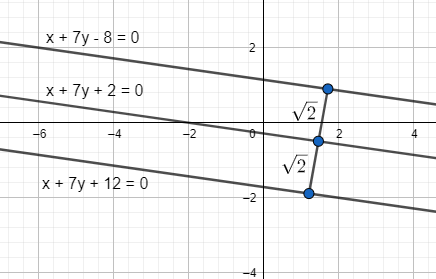
Find the equations of two straight lines which are parallel to $x+7y+2=0$ and at $\sqrt{2}$ distance away from it.
Answer
576.3k+ views
Hint: We start solving this problem by first considering the given equation of the straight line $x+7y+2=0$ . Then we start finding the equations of two lines parallel to the given line $x+7y+2=0$ and at a distance of $\sqrt{2}$ units from it. We consider the formula, the equations of the lines parallel to the line $ax+by+c=0$ are of the form $ax+by+k=0$ where $k$ is some constant. Then we use the formula, the distance between two parallel lines $ax+by+{{c}_{1}}=0$ and $ax+by+{{c}_{2}}=0$ is given by $\dfrac{\left| {{c}_{1}}-{{c}_{2}} \right|}{\sqrt{{{a}^{2}}+{{b}^{2}}}}$ . Then we equate the obtained distance to $\sqrt{2}$ to get the value of the constant term in the equations of required lines. Hence, we get the equations of two straight lines which are parallel to $x+7y+2=0$ and at $\sqrt{2}$ distance away from it.
Complete step by step answer:
Let us consider the equation of the given straight line, $x+7y+2=0$
Now, we find the equations of the lines parallel to the line $x+7y+2=0$.
Let us consider the formula, the equations of the lines parallel to the line $ax+by+c=0$ are of the form $ax+by+k=0$ where $k$ is some constant.
By using the above formula, the equations of the lines parallel to the line $x+7y+2=0$ are of the form $x+7y+k=0$ .
Now, we find the distance between the parallel lines $x+7y+2=0$ and $x+7y+k=0$.
Let us consider the formula, the distance between two parallel lines $ax+by+{{c}_{1}}=0$ and $ax+by+{{c}_{2}}=0$ is given by $\dfrac{\left| {{c}_{1}}-{{c}_{2}} \right|}{\sqrt{{{a}^{2}}+{{b}^{2}}}}$ .
By using the above formula, the distance between parallel lines $x+7y+2=0$ and $x+7y+k=0$ is given by
$\begin{align}
& \dfrac{\left| 2-k \right|}{\sqrt{{{1}^{2}}+{{7}^{2}}}} \\
& =\dfrac{\left| 2-k \right|}{\sqrt{1+49}} \\
& =\dfrac{\left| 2-k \right|}{\sqrt{50}} \\
& =\dfrac{\left| 2-k \right|}{\sqrt{25\times 2}} \\
& =\dfrac{\left| 2-k \right|}{5\sqrt{2}} \\
\end{align}$
But, we were given that the distance between the parallel lines is $\sqrt{2}$ .
So, we get,
$\begin{align}
& \dfrac{\left| 2-k \right|}{5\sqrt{2}}=\sqrt{2} \\
& \Rightarrow \left| 2-k \right|=5\sqrt{2}\times \sqrt{2} \\
& \Rightarrow \left| 2-k \right|=5\times 2 \\
& \Rightarrow \left| 2-k \right|=10 \\
& \Rightarrow 2-k=\pm 10 \\
\end{align}$
First, let us consider, $2-k=10$ , we get,
$\begin{align}
& 2-k=10 \\
& \Rightarrow k=2-10 \\
& \Rightarrow k=-8 \\
\end{align}$
Then we consider, $2-k=-10$ , we get,
$\begin{align}
& 2-k=-10 \\
& \Rightarrow k=2+10 \\
& \Rightarrow k=12 \\
\end{align}$
So, we got,
$k=-8$ and $k=12$
Therefore, the equations of the two straight lines which are parallel to $x+7y+2=0$ and at $\sqrt{2}$ distance away from it are $x+7y-8=0$ and $x+7y+12=0$ .
Hence, the required equations of the straight lines are $x+7y-8=0$ and $x+7y+12=0$ and can be plotted as below.

Note:
The possibilities for making mistakes in this type of problems are, one may make a mistake by considering the formula of the distance between two parallel lines $ax+by+{{c}_{1}}=0$ and $ax+by+{{c}_{2}}=0$ as $\dfrac{\left| {{c}_{1}}-{{c}_{2}} \right|}{{{a}^{2}}+{{b}^{2}}}$.
Complete step by step answer:
Let us consider the equation of the given straight line, $x+7y+2=0$
Now, we find the equations of the lines parallel to the line $x+7y+2=0$.
Let us consider the formula, the equations of the lines parallel to the line $ax+by+c=0$ are of the form $ax+by+k=0$ where $k$ is some constant.
By using the above formula, the equations of the lines parallel to the line $x+7y+2=0$ are of the form $x+7y+k=0$ .
Now, we find the distance between the parallel lines $x+7y+2=0$ and $x+7y+k=0$.
Let us consider the formula, the distance between two parallel lines $ax+by+{{c}_{1}}=0$ and $ax+by+{{c}_{2}}=0$ is given by $\dfrac{\left| {{c}_{1}}-{{c}_{2}} \right|}{\sqrt{{{a}^{2}}+{{b}^{2}}}}$ .
By using the above formula, the distance between parallel lines $x+7y+2=0$ and $x+7y+k=0$ is given by
$\begin{align}
& \dfrac{\left| 2-k \right|}{\sqrt{{{1}^{2}}+{{7}^{2}}}} \\
& =\dfrac{\left| 2-k \right|}{\sqrt{1+49}} \\
& =\dfrac{\left| 2-k \right|}{\sqrt{50}} \\
& =\dfrac{\left| 2-k \right|}{\sqrt{25\times 2}} \\
& =\dfrac{\left| 2-k \right|}{5\sqrt{2}} \\
\end{align}$
But, we were given that the distance between the parallel lines is $\sqrt{2}$ .
So, we get,
$\begin{align}
& \dfrac{\left| 2-k \right|}{5\sqrt{2}}=\sqrt{2} \\
& \Rightarrow \left| 2-k \right|=5\sqrt{2}\times \sqrt{2} \\
& \Rightarrow \left| 2-k \right|=5\times 2 \\
& \Rightarrow \left| 2-k \right|=10 \\
& \Rightarrow 2-k=\pm 10 \\
\end{align}$
First, let us consider, $2-k=10$ , we get,
$\begin{align}
& 2-k=10 \\
& \Rightarrow k=2-10 \\
& \Rightarrow k=-8 \\
\end{align}$
Then we consider, $2-k=-10$ , we get,
$\begin{align}
& 2-k=-10 \\
& \Rightarrow k=2+10 \\
& \Rightarrow k=12 \\
\end{align}$
So, we got,
$k=-8$ and $k=12$
Therefore, the equations of the two straight lines which are parallel to $x+7y+2=0$ and at $\sqrt{2}$ distance away from it are $x+7y-8=0$ and $x+7y+12=0$ .
Hence, the required equations of the straight lines are $x+7y-8=0$ and $x+7y+12=0$ and can be plotted as below.

Note:
The possibilities for making mistakes in this type of problems are, one may make a mistake by considering the formula of the distance between two parallel lines $ax+by+{{c}_{1}}=0$ and $ax+by+{{c}_{2}}=0$ as $\dfrac{\left| {{c}_{1}}-{{c}_{2}} \right|}{{{a}^{2}}+{{b}^{2}}}$.
Recently Updated Pages
Two men on either side of the cliff 90m height observe class 10 maths CBSE

What happens to glucose which enters nephron along class 10 biology CBSE

Cutting of the Chinese melon means A The business and class 10 social science CBSE

Write a dialogue with at least ten utterances between class 10 english CBSE

Show an aquatic food chain using the following organisms class 10 biology CBSE

A circle is inscribed in an equilateral triangle and class 10 maths CBSE

Trending doubts
Why is there a time difference of about 5 hours between class 10 social science CBSE

Write a letter to the principal requesting him to grant class 10 english CBSE

What is the median of the first 10 natural numbers class 10 maths CBSE

The Equation xxx + 2 is Satisfied when x is Equal to Class 10 Maths

Which of the following does not have a fundamental class 10 physics CBSE

State and prove converse of BPT Basic Proportionality class 10 maths CBSE




